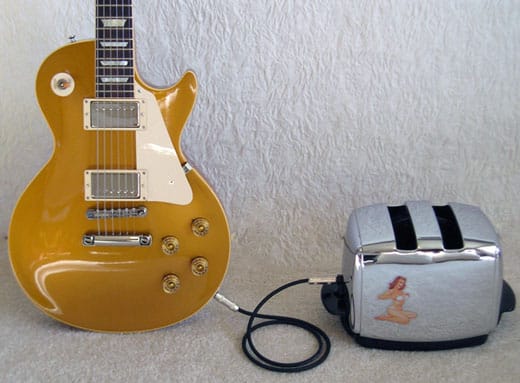
We all love guitar gear, right? That’s why you are reading this and also why I am writing this. We all love to chase tones, build rigs, obsess over what we don’t yet have, and generally annoy our wives and all other non-guitarists around us. It’s a given that we are going to spend our hard-earned bucks on gear of some kind, but today’s question is more specific than “buy or don’t buy.”
Today’s question is this: Is it better to have an expensive guitar and a cheaper amp or a less expensive guitar and a big-bucks amp? Which combination will provide the best tonal and cool-factor returns on the dollars spent?
Well, we here at GV have been debating this very issue over the course of many late-night staff meetings, golf outings, and class field trips to our local gentleman’s club. We think we have gotten to the essence of the topic and can now provide you with some sort of reasonable guidance in where your money should go. Interested? Read on.
When guitarists become more experienced, they tend to focus more on the amp than the guitar. They realize there is often a lot of hype and marketing to high-end guitars and they can get most of the sound of these axes by employing a less-ornate guitar or by customizing a cheaper axe with the pickups and parts of their choosing.
Many guitarists, especially younger ones and those relatively new to playing, tend to spend on a high-end guitar rather than on an amp. I have seen many American Paul Reed Smiths and Gibsons plugged into solid-state Crates and Peaveys over the years. I think this happens because, sometimes, to a less-experienced player, the guitar is the most visible evidence of their advancing status as a guitar player and was really the first object of musical desire, other than the actual ability to play. While there is certainly nothing wrong with having a nicer guitar, playing it through a lesser amp will still become a non-satisfying tonal experience most of the time.
The amp, however, is seen as the real tone generator and becomes the place where the bulk of gear money is spent. This is often a better-sounding approach than having a great guitar and a cheap amp and usually gets the guitarist in question closer to the tone they are chasing. I have worked in a guitar shop for many years and can tell you that this formula is often used on the sales floor when people are shopping. There is no better way to sell a $200 guitar than plugging it into a $2000 amplifier.
We are all free to buy and play what we like and many, of course, will only be happy when they have expensive amps AND expensive guitars. We salute these tonal purists and, in our hearts, aspire to be like them. But, when faced with the choice of having one or the other, of only having so much to spend, the combination of a better amp and a lesser guitar is the clear winner of this Fight Club. Your mileage may vary and we would like to hear about the rigs you all have put together out there in Gear-Vault-land so drop us a line and let us know how you roll. Next time: Ginger vs. Mary Ann. Now that will be a fight.




When guitars are discussed, price is not relevant to sound. Good electronics and proper set-up are huge. My Spectrum Strat was 99$. Neck angle adjustment, slight relief in neck, pup height adjustment, Lil 59′ in the bridge, adjusted saddle heights. It plays easier and sounds wicked sick compared to my Fender 50th anniversary. Go figure. Figure out what it lacks then go from there.
Hi Jeff,
It’s hard to find a guitar with decent wood for $99. I agree if the guitar is in the $250-$300 range. Example would be an Agile guitar.